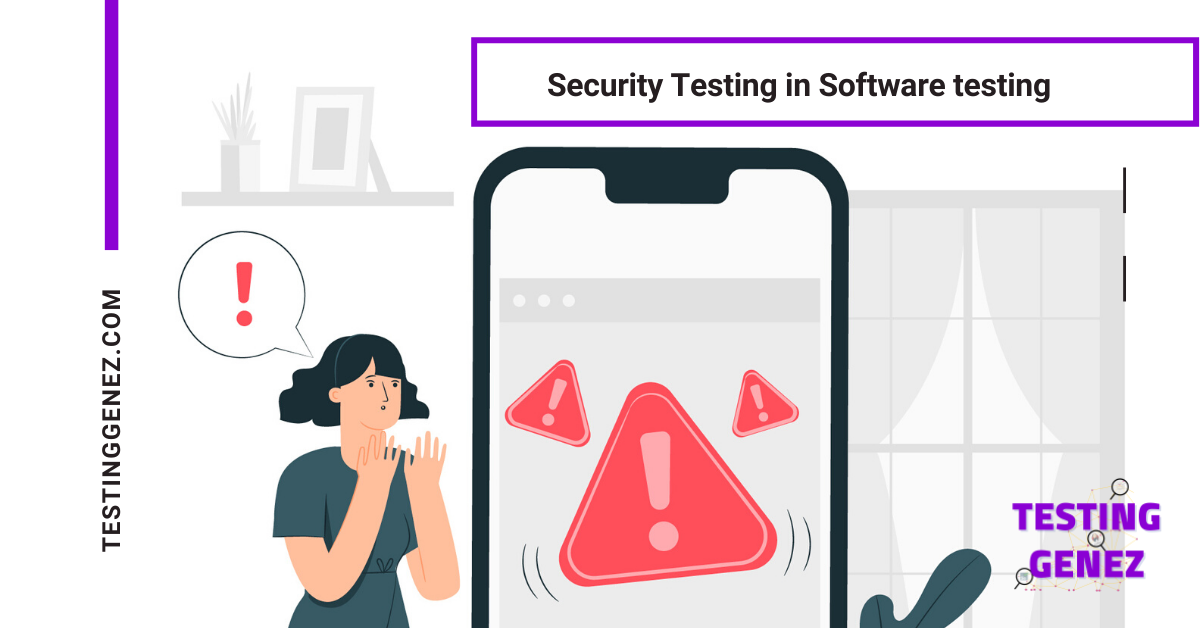
Security Testing in Software Testing | Types of Security Testing
Vulnerabilities in the system are inevitable in most of the cases.
Every tester needs to check and consider different kinds of vulnerabilities in every system.
It helps them to fix errors and bugs at the earliest easily.
Know more about Security testing in software testing process to have a fair idea about the importance of fixing bugs regularly.
Testing is a type of activity, which has to be done for application.
Every application in both computers and mobile would consist of data.
The data ranges from less importance to highly classified documents.
It is essential to protect the data available in the system by performing some of the security practices.

What is Security Testing
Security testing is a part of software testing.
It mainly focuses on looking for any possible leaks or loopholes in the system.
Some of the loopholes gives away the entire system, which may cause severe problems for both customers and the business.
Information theft is one of the major battles being fought in the world today.
The theft or the loss of information has the capability to bring down the entire business.
Security testing ensures to offer a thick wall between the intruders and the company in a professional way.
A perfect gated system helps you in maintaining both information and the reputation of the organization.
Security testing in software testing is commonly done using tools.
Some of the important and quality tools are listed at the end of the article.
You find more than a couple of tools in the market.
Some of the old-timers or experienced professionals prefer to use both manual and automated ways of completing the task in a perfect way.
Security testing tutorial
The objective of Security Testing
Security testing finds bugs or errors in the system, which mainly allows intruders to grab or steal data.
Data stealing costs a lot for most of the organizations.
A must-do and straightforward activity resolves all the problems and restrains illegal attempts to a significant extent.
Every testing activity is performed to take out or figure out some of the small and crucial bugs in the system.
There are various kinds of testing done on an application to achieve multiple benefits.
Security testing is one of the important ones for business and finance related applications.
Security testing in software testing is one of the mandatory activities to keep applications secure.
Now, various processes are being used to complete the process.
Therefore, it is essential to understand some of the commonly followed procedures and the ultimate objective of security testing.
Commons Steps to follow in security testing.
- Identify bugs or threats in the application.
- Calculate the crucial and potential vulnerabilities.
- Detection of possible security risks in the application.
- Finds a way to help fix errors for developers with the help of coding.

7 Different types of security Testing
It is a known fact that security testing is performed with the help of both automated tools and manual processes.
Some of the systems or applications are known to have delicate elements, which require manual intervention.
Hence, application security testing is essential for every system across the world.
There are different types of software testing, and Security testing is one among them.
So, the types of security testing defined in various stages to have an organized activity.
Vulnerability Scanning
There are more than a few automated tools found online to perform security testing.
So, it is essential to make use of them to save both time and effort.
Vulnerability scanning generally takes place to scan any of the familiar and comfortable vulnerabilities in the system.
Most of the tools are known to offer a fair number of bugs with quality.
Hence, it is easy for the testers to proceed with the next step after finding flaws in the system.
Security Scanning
Security flaws are found in every system in one way or another, and that causes a severe threat.
To overcome deficiencies, it is essential to identify the code or the location to fix bugs in a natural way.
The second step of security testing is performed in both manual and automated modes.
The automated scanning process takes place with the help of third-party tools. Some of the tools provide possible solutions that can be used to fix bugs quickly.
Penetration testing
Penetration testing is also called a dry run testing step because of various reasons.
The process involves simulating an attack from a hacker.
Some of the ethical hacking experts are also invited to perform a generic attack on the system or a site.
Penetration testing reduces the risk of taking hits from hacking experts from different parts of the world.
A malicious hacker would also be introduced to perform an attack to discover possible bugs in the system.
The analysis of the testing activity allows testers to find any kind of potential vulnerabilities.
Therefore, penetration testing is commonly performed by both external and internal hackers from different parts of the world.
Risk assessment
Generally, risks and threats are found in different kinds of levels.
Some of the risks are left ignored because it helps in focusing on high-level risks.
The analysis found the above step allows an organization to categorize based on genuine and vital.
Once the risks are evaluated into low, medium, and high, bug control teams get into place to fix them.
Risk assessment plays a vital role in some large-scale applications because it takes a long time to find and fix it based on the necessity.

Security Auditing
The inspection from an internal team to look at risk assessment is performed to start with bug fixing exercises.
It is essential to know and understand the organizational structure and the functionalities thoroughly because it lets them audit the risks effectively.
The application and the operating systems are inspected to find any kind of flaws associated with security.
A small audit takes place for the code inspection and quickly completes the auditing.
Ethical Hacking
Ethical Hacking is indeed used for testing purposes.
Trying to gain control illegally is one of the major aspects to consider in Security testing.
Ethical hackers and professionals attempt to gain access to systems using malicious ways.
Software security plays a significant role because it compromises with data and resources.
The ethical hacking step allows you to expose or display any flaw in the safety of the system.
Posture Assessment
A combination of all the steps are followed in the step.
Posture assessment is the last step in the process.
Therefore, it is good to revise all the steps to ensure a smooth flow of release.
Posture assessment includes several steps re-done such as ethical Hacking, security scanning, and risk assessments.
The overall report of the security vulnerabilities shows the quality of the system or an application.

5 Best open source Security Testing Tools with highlights
Wapiti
One of the commonly used open source security tools available in the market.
The free of cost application is a project developed by Devloop and SourceForge.
Wapiti also takes care of Black Box testing because it checks security vulnerabilities efficiently.
Wapiti is a command-line application.
Hence, testers should have good knowledge and ideas about various commands used in the tool.
Beginners explore multiple aspects of security and enjoy the excellent experience over some time.
Highlights of Wapiti
- Buster module availability and allows brute force directories on the target web server.
- Supports both POSTHTTP and GET kinds of attacks.
- Enables secure authentication through Kerberos and NTML.
Wfuzz
Some of the applications have rigorous security testing because it deals with susceptible information.
Most popular ecommerce sites prefer intensive security testing because it requires a brute force testing analysis from time to time.
Wfuzz is a python product and commonly used to test any kind of brute force attack on systems.
Some of the web applications prefer using Wfuzz because it easily supports multiple languages.
The tool comes with unique features, which allows it to expose vulnerabilities like LDAP injection, XSS Injection, and SQL Injection.
Highlights of Wfuzz
- Good support for authentication
- Multiple injection points and Multi-threading
- Cookies fuzzing
- Efficient support for SOCK and Proxy
W3af
The tool is one more product developed using Python.
The tool is popularly used in various security testing frameworks for multiple reasons.
Working on security testing frameworks is challenging if you are not using a useful tool.
W3af is one of the blessed and effective tools to blind SQL injection quickly and correctly.
The tool also allows testers to find every minor and major security issue hidden in the system.
Therefore, it is easier for an examiner to show a good and long report to clients.
The free or open source applications can find over 150 kinds of security vulnerability.
The list is higher compared to any other tool in the market.
Highlights of W3af
- Authentication support
- Easy to use and test
- Attractive and friendly interface
- Easy output logging system

SonarQube
The reason behind having bugs could be plenty.
Finding the exact source code gives you experience and knowledge over finding bugs.
Every web application consists of a wide variety of codes.
Hence, finding the source code quality gives you an abundant amount of knowledge over the system.
SonarQube is a free security testing tool for multiple users because it supports over 18 programming languages.
Besides, the easy to use interface gives you an option to integrate with other tools for better convenience.
Highlights of SonarQube
- Tricky issues detection
- Integration with DevOps
- Analysis set up
- Quality tracking supported
- Quality gate options
- History of the project visualization
Grabber
Web applications are designed based on necessity and demand.
Every web application consists of various codes and modules.
It is important to test every part of the web application with the help of the right tools.
Grabber is one of the best tools that is available for free of cost.
It is specially designed to scan and perform security testing activity on small scale web applications. Small scale applications do not require brute force testing activities.
Hence, Grabber is used to having simple and necessary testing easily.
Grabber comes with an easy to use interface to conduct security testing.
It helps in uncovering vulnerabilities like Backup files verification and Simple AJAX verification.
Key Highlights
- Easy Stats and analysis file Generation
- Portable and lightweight application
- JS code analysis

Conclusion
The data and resources have to be protected by performing security testing in software testing activities.
Security testing confirms the system and reports on security problems.
Either a team of testers or a developer takes care of the bugs.
Hence most of the reputed system stays free from any kind of threat in the world of the internet.
Testinggenez is one of the reputed software development and testing companies located in Bangalore, India.
We offer testing services to both small scale and large scale organizations. Check out some of our test cases and studies performed for various of our clients.


